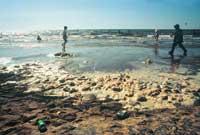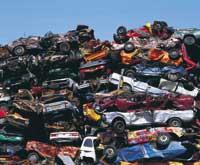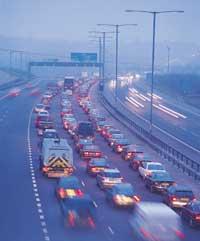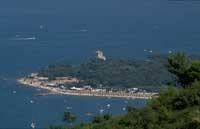European environmental health
The European Environment Agency recently published the TERM 2001 report. This report analyses the balance/imbalance between transport and the environment. As a general conclusion, the situation of transport in Europe is getting worse from an environmental point of view.

The pressure of transport on the environment is increasing. Vehicles and aircraft that circulate on roads emit toxic pollutants and greenhouse gases, generate waste, generate noise pollution and fragment the territory due to road construction. According to the TERM 2001 report, there is still much left to make transport a green sector. The European Union wants to give importance to rail, maritime and river transport by 2010, eliminating both aircraft and road. The trend is different.
The car and the plane have become the main means of transport, increasingly important. Consequently, the transport sector consumes more energy than ever. Data: Since 1985, energy consumption in the transport sector has grown by 47%, while in other economic sectors it has grown by 4.2%. At the same time, greenhouse gas emissions have increased considerably. According to the report, 24% of the carbon dioxide emissions produced in Europe are due to the transport sector, while in 1990 the percentage was only 9%.
The increase in these greenhouse gases is not surprising, since between 1980 and 1998 the number of vehicles in Europe increased by 64%. In this period of time, there were 451 vehicles per 1,000 inhabitants, almost one vehicle per two people. As a result, the vehicle that is damaged and discarded has also increased.
"According to the TERM 2001 report, 11.300,000 vehicles were roughed in 1995, a figure that in 2015 would amount to 17 million. While the number of fatalities due to road accidents has decreased, the number of accidents has increased, the number of casualties has also increased. According to the report, on the roads of the European Union it is estimated that every year there are about 41,000 people who lose life, while the number of injured is 40 times greater.

In addition to losses in accidents, the transport area is causing further damage. If the accidents are added ecological damage and loss time on the road, experts say that the indirect cost of the transport sector represents approximately 8% of the European Gross Domestic Product. When talking about ecological conditions, it is necessary to consider the road network itself, since the infrastructures necessary for transport are fragmenting the territory. Since 1980 the length of European motorway networks has increased more than 70%, while that of conventional rail networks has decreased by 9%. This means that road transport is increasingly important. Currently, as for the transport of goods, 43% of the tons per kilometer are transported by road, compared to 33% in 1980.
Everything, however, is not bad, but the TERM 2001 report also collects trends that can be positive for the environment. The benefits are mainly due to technological advances and new fuels, which have allowed the commercialization of increasingly less polluting vehicles. Cars have also gained in efficiency, need less energy to move better; however, when leaving cars with higher power and often when driving only the driver, technological efficiency is not as good as expected. In addition, many countries have begun to look at how the vehicle will affect the environment and to establish more concrete fiscal policies. Of course, the strategy for these measures to be effective must be combined.
Tourism to the detriment

When it comes to transport, although in most cases goods are remembered, passenger journeys are also important, especially those due to tourism.
The European Union Environment Agency published for the first time last year the report entitled "Environmental Indicators". This paper analyzed various aspects related to the environment to see how it was being managed in Europe. After analyzing greenhouse gas emissions, river situation, energy consumption, etc., the report highlighted the bad and good indicators in these areas. Despite just a year, this report has become the main indicator of the environmental situation in Europe.
This year the report "Environmental Indicators" has been published for the second time. Apart from the results, this report presents two new aspects regarding the previous year, in terms of its structure: domestic consumption and tourism.
Between these two areas has given special importance to tourism. Tourism, because of its impact on the environment, is an initiative that no longer only worries it but generates problems. According to the data collected in the aforementioned report, tourism consumes half of the energy used in the transport sector, that is, 15% of the energy used in the European Union.
70% of air traffic says it is related to tourism. However, the most worrying thing is the traffic condition. In the case of France, for example, the report notes that about 7% of the polluting gases come from tourism, since 80% of the trips made inside the country are made in private vehicles.
The European Union Environment Agency has recalled that the Mediterranean is the most important tourist centre in the world and is also being targeted by more and more tourists. In 1990 260 million tourists chose somewhere in the Mediterranean to spend their holidays; the number of visitors is expected to reach 655 million by 2025. The report "Environmental Indicators" highlights the case of the Balearic Islands, where around 800,000 people live throughout the year, but there are 11 million visitors.

There is no doubt that tourism is a big business, one of the largest industries in the world. Tourism generates numerous investments, generates income and employment, often provisional. However, in the name of tourism benefits nothing should be accepted. The European Union is also convinced of this and concludes that the tourism industry must evolve sustainably in the future, since "few interested in visiting the mountains devastated by wild tourism and contaminated beaches".
Other environmental indicatorsIn addition to the environmental variables that may be related to transport, this year's "Environmental Indicators" report includes the rest of the variables. The details are numerous, but the conclusions are summarized in several points.
|
Published in the supplement Natura de Gara.
Buletina
Bidali zure helbide elektronikoa eta jaso asteroko buletina zure sarrera-ontzian











